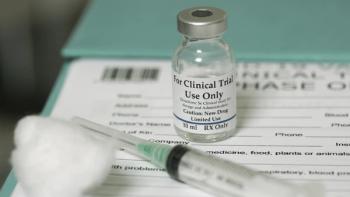
New study demonstrates Xiidra's efficacy in alleviating discomfort in symptomatic contact lens wearers
Xiidra is a prescription eye drop used to treat the signs and symptoms of dry eye disease (DED) and works by targeting the source of inflammation.
Results from a recent study published in Clinical Ophthalmology were found to reinforce previous clinical studies that have demonstrated that Xiidra (lifitegrast ophthalmic solution; Bausch + Lomb) 5% significantly reduces symptoms of eye dryness over 12 weeks.1,2 The investigator-initiated, prospective, open-label study evaluated whether end-of-day comfort and dryness in symptomatic soft contact lens wearers improved after using Xiidra twice a day for 12 weeks while wearing their usual contact lenses, according to a news release.
Xiidra is a prescription eye drop used to treat the signs and symptoms of dry eye disease (DED) and works by targeting the source of inflammation.1
“Although the use of OTC rewetting drops provides temporary relief for some wearers, their benefit is only moderate and contact lens discomfort typically worsens as the day progresses,” said Andrew Stewart, president of Global Pharmaceuticals and International Consumer at Bausch + Lomb, in the release. “This study showed that Xiidra may be a suitable alternative for symptomatic contact lens wearers who can’t achieve comfort or relieve dryness by switching their contact lenses or using OTC drops.”
A total of 40 participants were involved in and completed the study. The performance of Xiidra was assessed by comparing ratings on a visual analog scale (VAS; 0-100 scale; 100 worst) at 2, 6, and 12 weeks for end-of-day dryness and discomfort, in addition to Contact Lens Dry Eye Questionnaire-8 (CLDEQ-8) scores to baseline levels.1,2
“An interesting observation from this study was that the mean age of the study population in this study (30.8 years of age) was significantly lower than the mean participant age in the phase 3 studies (58.7 and 58.8 years of age, respectively),” the study authors, led by Marc-Matthias Schulze, PhD, Dip Ing, principal investigator and senior clinical scientist at Centre for Ocular Research & Education (CORE) at the School of Optometry and Vision Science, University of Waterloo in Waterloo, ON, stated.2 “While a younger age in contact lens wearers is not surprising, the severity of contact lens-wear related symptoms in many of these relatively young study participants emphasizes the need for clinicians to continuously monitor and address patient-reported symptoms of discomfort and dryness, for example, by modifying the lens wear modality or lens care product or introducing OTC or prescription eye drops.”
The study met its primary end points, with a median VAS score improving by 61 and 59 points on the 100-point scale for end-of-day dryness and discomfort, respectively, after 12 weeks of Xiidra use. Additionally, the drops resulted in a significant reduction in contact lens wear-related end-of-day dryness and discomfort after 2 and 6 weeks compared with baseline. Dryness symptoms also improved in almost half (45%) of the study participants to the point where they would not have met the symptom-related eligibility criteria for the study after 2 weeks of treatment.1
Additionally, CLDEQ-8 scores significantly reduced compared with baseline at the 2-, 6-, and 12-week follow-up visits. Specifically, a 6-point reduction was reported for symptomatic wearers of 17 different contact lens types after 2 weeks. These scores continued to decrease over the 12-week study period. After those 12 weeks, 90% of participants achieved clinically meaningful improvements of at least 3 points in the scores compared with baseline.1
“The significant improvements in symptoms of end-of-day dryness and discomfort for contact lens wearers in as little as 2 weeks highlighted the effectiveness of Xiidra, even after a short period of use,” said Schulze in the release. “Additionally, results showed continued use of Xiidra throughout the study further improved symptoms, demonstrating that Xiidra remains an effective treatment over time and may allow contact lens wearers to enjoy their lenses throughout the entire day.”
Other VAS symptoms were also shown to improve, including burning/stinging, itching, foreign body sensation, photophobia, and pain. This improvement was reported as early as 2 weeks and continued throughout the study period. An increase in mean comfortable contact lens wear time also increased from 6.5 hours at baseline to 9.1 hours at 12 weeks. However, there were no changes in total wear time during the study.1
Additionally, Xiidra was well tolerated, with the study indicating that contact lens wearers could safely use the drop.1
References:
Bausch + Lomb announces publication of data from a prospective study evaluating the efficacy of Xiidra in alleviating discomfort in symptomatic contact lens wearers. News release. Bausch + Lomb. September 9, 2025. Accessed September 9, 2025.
https://www.bausch.com/newsroom/news/?id=285 Schulze MM, Guthrie SE, Ho B, Woods J, Jones L. A clinical evaluation of lifitegrast ophthalmic solution 5% in symptomatic contact lens wearers. Clin Ophthalmol. 2025;19:3033-3049.
https://doi.org/10.2147/OPTH.S538184
Newsletter
Want more insights like this? Subscribe to Optometry Times and get clinical pearls and practice tips delivered straight to your inbox.














































.png)


